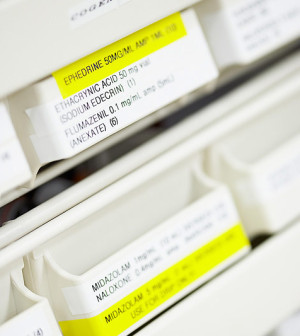- Fragments of Bird Flu Virus Found in U.S. Milk Supply
- There’s an ‘Epidemic’ of Loneliness Among U.S. Parents, Poll Finds
- Infertility Is Rising Among Young Married Women
- New Rules Mean 3.6 Million Americans Could Get Wegovy Via Medicare, Costing Billions
- ‘Dream It, Be It?’ Study Finds Teens Who Focus on Life Goals Often Succeed
- Trying ‘Magic Mushroom’ Drug to Ease Depression? It Has Side Effects
- $282 Billion: What Mental Illness Costs America Each Year
- Black, Hispanic Americans Getting Savvier About CPR
- Kids With Common Skin Conditions Face Stigma, Bullying
- Science Reveals How Aspirin Prevents Colon Cancer
‘Cash for Lower Cholesterol’ Program Works With Doc-Patient Teams

What if you could get paid to improve your health? That was the premise behind a new study that offered cash rewards to help people lower their cholesterol levels.
Surprisingly, the program was only successful when both the doctor and patient were paid to work together to achieve the common goal, the study found. Patients who shared a financial incentive with their doctor to lower their levels of LDL (“bad”) cholesterol achieved a statistically significant reduction after a year of treatment, the study authors said.
LDL cholesterol levels didn’t significantly drop if the cold hard cash was offered to either the patient or the doctor alone, the study revealed.
These results provide fresh evidence for the value of shared decision-making between doctor and patient, said lead author Dr. David Asch, a professor of medicine and executive director of the Center for Health Care Innovation at the University of Pennsylvania in Philadelphia.
“It makes sense. It does take two to tango,” Asch said. “The physician has to prescribe the medication, and the patient has to take it. They both have to follow through on their roles for this to work.”
At the same time, the findings raise questions about the value of straight “pay-for-performance” incentives offered to physicians, where doctors receive cash bonuses if they achieve certain health goals among their patients, Asch added.
“There’s been an enormous amount of attention placed on pay-for-performance, without a lot of evidence,” he said. “It’s largely untested, and this study shows that we may need more clever designs that incorporate both the doctor and the patient.”
The findings were published in the Nov. 10 issue of the Journal of the American Medical Association.
The study involved 340 primary care physicians at three northeastern U.S. medical clinics, and just over 1,500 of their patients.
All of the study volunteers were provided with an electronic pill bottle to track whether they took their cholesterol-lowering medications (statins) on schedule. Each physician/patient team was placed into one of four groups. In one group, doctors were offered up to $1,024 for each patient whose cholesterol met a target goal. The second group offered the same cash reward to patients who took their medication on time, but nothing for doctors.
The third group offered shared incentives, with both doctors and patients eligible for bonus cash if they held up their end of the bargain. And finally, the fourth group served as a control group that was offered no cash bonuses at all. (Patients and doctors in all groups, including the control group, were paid $355 just to participate in the trial.)
Only patients in the shared physician-patient incentives group achieved reductions in LDL cholesterol levels that were statistically different from those in the control group, the researchers found.
However, the difference was just 8.5 mg/dL, which amounts to only a 4 percent reduction in cardiovascular events such as strokes or heart attacks, said Dr. Pam Morris, chair of the Prevention of Cardiovascular Disease Committee for the American College of Cardiology.
“It was a very modest effect,” said Morris, an assistant professor and director of preventive cardiology at the Medical University of South Carolina. “It raises questions about the cost-effectiveness of this model.”
Morris also noted that most patients failed to take their medication even when offered cash bonuses. Average adherence rates were 39 percent in the shared-incentive group, and 34 percent in the patient-incentive group.
“I found really shocking the incredibly poor adherence across all groups, even for those with financial incentives,” she said. “They were being offered money. What does it take to get the type of adherence to therapy that will improve health? What more do we need to do?”
Asch agreed that the effects of financial incentives were not as big as he had hoped, but pointed out some factors that make the patients’ improvement more significant than it might otherwise appear.
For one thing, people recruited for the study already were receiving treatment for high heart risk and elevated cholesterol. “These were not easy patients,” Asch said. “To get into the study, you had to be something of a hard case. We targeted the hardest cases to treat.”
At the same time, the control group received electronic pill bottles along with everyone else, which could have given those patients a subtle reminder to take their cholesterol-lowering drugs on time, he said. The control group had an adherence rate of 27 percent.
“We did not compare the rest of the patients against nothing,” Asch said. “We compared them to people who’d been given electronic pill bottles.”
The research team now is embarking on a cost-effectiveness analysis to see if these cash incentives would pay for themselves in improved care and decreased medical costs, Asch said.
If the improvements in health prove worth the cost, Asch said he could imagine employers or insurance companies offering such incentives to drive down future costs of health care.
“The stakeholder who winds up holding the ‘hot potato’ of financial risk at the time might be the one who’s willing to pay the cost,” he said.
More information
For more about cholesterol, visit the U.S. National Institutes of Health.
Source: HealthDay
Copyright © 2024 HealthDay. All rights reserved.










